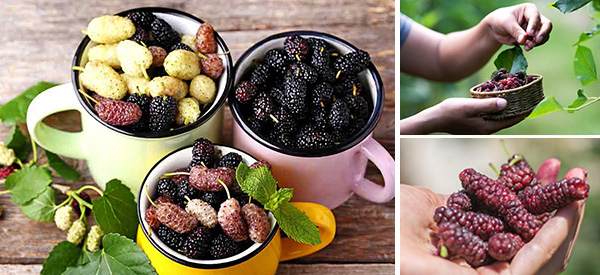
How to Use Mulberry Medicinally
Mulberry season is finally here!
Mulberry is a flowering tree known for its berries, which are often used for culinary purposes. Mulberries belong to the genus Morus, and the term is used to describe many different species. The most common species of mulberry are the red, white, and black mulberry, Morus alba, rubra, and nigra. However, the color in the species name does not necessarily reflect the color of the berries the plant produces, it refers to the original cultivar. All mulberries can produce white, red, black, and even purple berries that can be both sweet and tart. Mulberry is also known for its traditional medicinal uses, especially in Chinese medicine.
Superfood
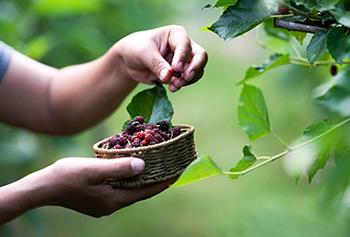
Mulberries were first cultivated in China in about 2500 BCE as food for the silkworm. While as early as 4000 years ago the Chinese were documenting the medicinal uses of the plant in their classic medicinal textbook, the Huang Di Ba Shi Yi Nan Jing it is only recently, mulberry has garnered attention in the west.
Nowadays mulberry is considered a superfood, like kale or almonds. The berries are rich in antioxidants, fiber, and protein. Studies show mulberry can be effective in controlling blood sugar in diabetics, helping lower blood pressure and cholesterol, and having anti-aging properties.
Distribution of Red and White Mulberry
While the white mulberry is native to Asia, the red mulberry is native to the US. The white mulberry was first imported to the US in the 1600s to promote the American silk industry. Both species can be found growing throughout the US both under cultivation and in the wild.
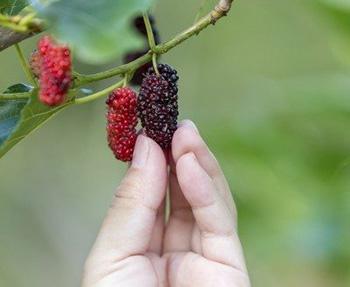
White mulberry is found in 48 states the exception being Nevada and Alaska.
Red mulberry is found in the eastern US and Canada. It can be found as far north as Vermont and Ontario and as far south as Florida. Its territory stretches west as far as Texas and South Dakota.
In Canada, it is endangered from hybridization with the imported white mulberry.
How to distinguish between Red and White Mulberry
If you are in a region where both varieties of mulberries grow you will want to know how to distinguish them. The first factor to consider is the environment. Red mulberry is a shade-loving tree. It does not tolerate direct sunlight. White mulberry is much less discerning about where it grows. You can find it growing along fence lines and in urban areas. While you may associate mulberry with the nursery rhyme, “All around the mulberry bush” mulberry is in fact a tree. The red mulberry is slightly smaller, usually topping out at 55 feet tall, the white mulberry can grow to heights of 66 feet or taller. As you investigate further you will find there are differences between the leaves of these two trees.
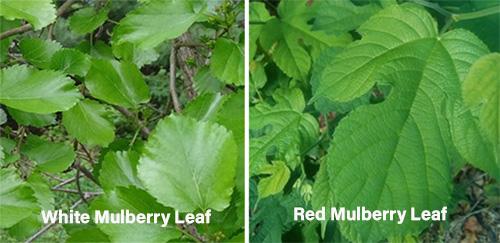
The leaves of the red mulberry are larger, ranging from 4-10 inches with smaller more pointed serrations on the edges. Dark green, they have a rough, dull surface and the underside is lightly hairy with small veins. In contrast, white mulberry leaves are shiny, bright green, with rounded serrations more like teeth. They are hairless below with the exceptions of the distinct main veins which may have hairs. These distinctions are important as the leaves are commonly used medicinally. It can often be difficult to determine the species of mulberry because of the hybridization that is occurring between the two species.
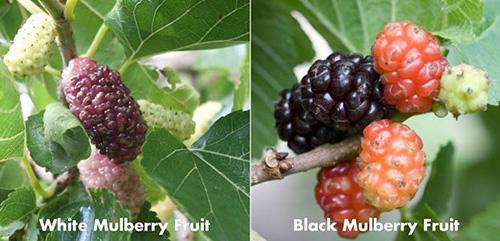
Another way to determine the species is the fruit. Red mulberries grow singly from the stem, while white mulberries grow in clusters. But color is not necessarily a distinguishing characteristic. Both species have white fruit when the fruit is immature. It then darkens. The red mulberry tends towards a darker purplish red. The white mulberry can be lighter in color pink tending towards reddish.
Medicinal Uses
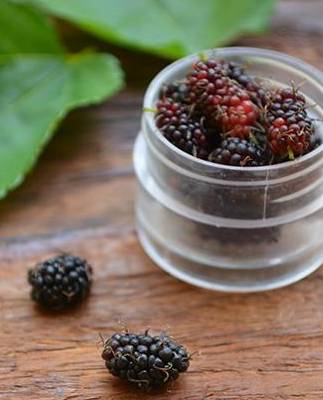
White mulberry has been used in traditional Chinese medicine to treat a range of conditions including:
- Anxiety
- Arthritis
- Colds and Flu
- Circulation
- Diabetes
- Headaches
- High Blood Pressure
- Cholesterol
- Sore Throat
- Cough
While the leaves are most commonly used, the root bark, bark, and stems are also used in many remedies.
Leaves
The leaves can be used in either teas or tinctures. Young leaves can be eaten as well, as long as they are cooked. Mulberry leaves do contain a latex sap that can be irritating to some people and cause stomach upset. You can also purchase the leaves as a supplement. Mulberry leaves have been shown to help regulate blood sugar, and help with heart disease by lowering blood pressure and cholesterol. An easy way to enjoy the benefits of mulberry is to make this delicious and refreshing tea.
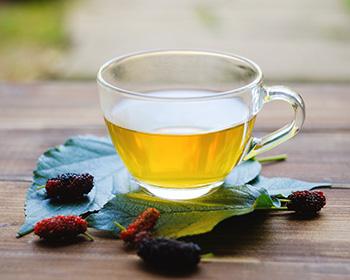
Mulberry Tea
2 TBSP mulberry leaves
- 4 cups of water
- Honey to sweeten
Simply add either fresh or dried mulberry leaves to a pot of water and slowly heat for 10-15 minutes. Strain the leaves. Add honey to taste.
Branches, Twigs, and Root Bark
While the leaves are the most commonly used part of the mulberry tree, other parts are used traditionally. The branches and twigs are said to help with arthritis pains and to help stimulate circulation to the extremities. The root bark is said to help with coughs, colds, and flu. It is also said to help reduce fever.
Fruit
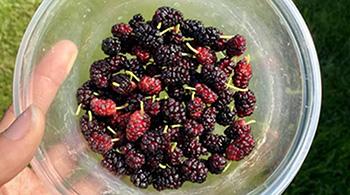
Perhaps best known for the sweetness of its fruit it is important not to neglect the health benefits of the berries. Used traditionally in jams, pies, and wine mulberries are full of anti-oxidants, iron, and vitamin C. Eaten either fresh or dried mulberries are a healthy and delicious snack.
Mulberry has been valued since ancient times, not only as a food for the precious silkworm but also for its culinary and medicinal uses. It is easy to see why such a plant has been memorialized in legends and children’s rhymes. Whether you chose to enjoy a handful of dried berries or relax with a cup of delicious mulberry tea, you can be confident you are following a long line of people who appreciate the health benefits of this amazing plant.
You may also like:
Natural Collagen-Boosting Gummies
WARNING: Green Veggie Causing Type 2 Diabetes In Millions (Video)
25 Medicinal Plants You Can Forage Right Now

We had a midsized, prolific Red mulberry alng our community fenceline at the house in town.
Good tree, bad spot.
The birds that came in carried a kudzu-like plant with them, and the slightest monthly inattention let it get out of control.
The tree has been gone 3 years now and we still battle the vine, and Mulberry volunteers all over the ‘hood.
Somewhere else it would be just fine.
Hi Chip,
Thank you for sharing this with us.
I’m sorry to hear that your Mulberry Tree was in a bad spot.
Many blessings!
Iam confused about white mulberry a they white or red when ripe or both
Hi James,
Thank you for your comment.
Black mulberry and White mulberry are the most known species among the 10 species. But White Mulberry is the one used for this recipe, and in general, has the most medicinal benefits.
Many blesssings!
I have a white mulberry tree. The berries only get a tinge of pink on them when very ripe.
Is there a difference between the red and white mulberry leaves medicinally? Is one better than the other for specific issues?
White mulberrys turn a pinkish to light purple when rip and red mulberry turns dark purple to a almost black when ripe
Are the branches and twigs also made into a tea?
Hi Celia,
Mulberry bark is considered safe as well.
The root bark of the mulberry tree possesses antitussive, expectorant, diuretic and hypotensive properties. It is also used internally in the form of decoction to treat medical conditions, such as coughs, bronchitis, asthma, hypertension
The typical dosage of mulberry bark is between 10 and 15 grams, decocted in water. Raw mulberry bark should be used to induce diuresis, calm the liver and clear away fire.
Many blessings!
The bark can be broke down into a tinkerer but no u dont use the wood part
I have 2 huge ‘fruitless’ mulberry trees in my yard. Can the leaves be used for tea as the same as the trees that produce the fruit?
Hi Victoria,
Leaves are highly nutritious. They’re loaded with powerful plant compounds like polyphenol antioxidants, as well as vitamin C, zinc, calcium, iron, potassium, phosphorus, and magnesium.
– 2 tablespoons dried mulberry leaves
– 4 cups cold water
– 1 teaspoon honey to sweeten if desired
You can also brew mulberry leaf tea with fresh mulberry leaves. Simply add four cups of cold water to a pot with fresh mulberry leaves and gently heat over the stove for 10-15 minutes.
Many blessings!
My red 8 yr old healthy mulberry tree never fruits! Does it need a pollinated tree. Do they make volunteers so many weeds around cant tell.
Hi Theresa,
The tree can be affected by temperature and moisture levels and if the roots become dry the fruit is likely to drop before it is fully ripened.
Fruit is only produced on female mulberry trees, while male trees produce pollen. A good variety of both trees will ensure that the flowers of the female trees are pollinated and produce abundant fruit.
Mulberries perform best when roots are kept moist but not wet.
You can also fertilize your mulberry trees with a fertilizer that is rich in potassium. It helps to increase the blossoms in plants, which leads to more fruit production.
Many blessings!
Thanks for that information. It will be helpful to improve the lack of fruiting. I should probably get another tree for pollination. My tree is not a white. Large not shiny leaves. Healthy but possibly dry at times. In a barren soil so I will change that. Just need to know how to get an appropriate pollinator. Any suggestions are appreciated. Thank you so much
Deer and horses love mulberry leaves and fruit. My iguana loves them too.
I’ll have to look for these next summer!
i just planted 3 black mulberries, and wonder if i plant white and red if they will cross pollinate, or change?
We have several mulberries around our property and last year the trees were loaded with fruit. I put several bags in the freezer and made a couple of batches of jelly. Good thing because this year we have been in a continual drought for 3 months and have not a bit of fruit on the trees. Wild grapes are also non-existent this year.